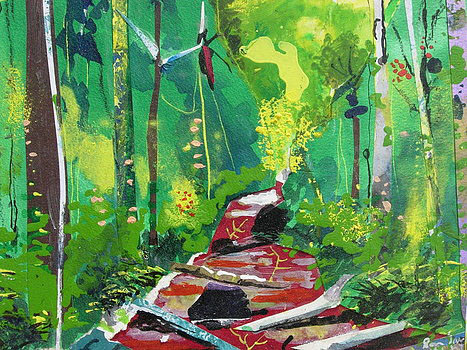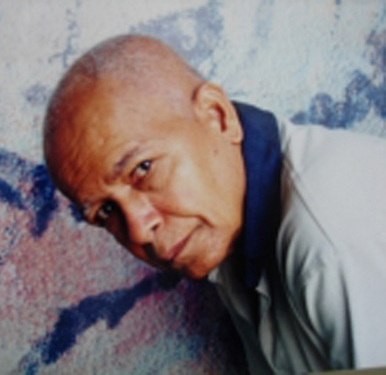By Stanley Greaves
Before commenting on Ron Savory the artist, note must be taken of his association with the Theatre Guild in charge of lighting electronics and stage setting. He too, like Marc Matthews, was a member of Ravens, the first basketball team founded by Ken Corsbie who had introduced the sport to Guyana. Savory was very knowledgeable in Jazz and Classical music and produced the British Council Classical programme on Sundays. He would also invite friends at his home listen to CD’s. Like Wordsworth Mc Andrew he was trained in Radio at the BBC as a producer-announcer and worked for Guyana Broadcasting Corporation before leaving for Barbados and St.Lucia finally.
Savory studied Art with E.R.Burrowes at Queen’s College in the 1950’s. He later joined Burrowes’ Working People’s Art Class producing small format paintings for a while. The breakthrough came with his appointment as a Civil Servant to the District Commissioner’s Office at Kamarang in the Mazaruni. For so many of us visiting the rainforest the twilight zone of its canopy is quite a visual delight where, despite the light, shadows become “shadowy”, almost nonexistent, quite unlike those defined by strong sunlight. Savory responded to this experience and began working on two fronts using images from his contact with the life and culture of our indigenous peoples -the canoes by creek and riversides and Timehri symbols, and the striking quality of light in the forest. He also experimented with sand to create textures providing additional feeling to the usual flat surfaces of pictures. These early works were shown in a 1961 exhibition along with Michael Leila, Emerson Samuels and myself held on the upper floor of Bookers Universal Building.
After these works he soon began to focus more on the forest itself attempting to capture the effect of sunlight filtering through leaves and between sky reaching tree trunks. This allowed him to capture the wide range of greens, yellows and browns creating a living informal pattern almost abstract in quality while still referencing leaf shapes with occasional presentations of birdlife. The forest floor which could also provide a range of colours mainly in browns and yellows, did not capture his full attention and was infrequently referenced in some works. Paintings began to increase in size and one could well imagine compositions extending beyond frames. He did in fact produce a mural for the Pegasus Hotel which was subsequently painted over despite protests. In works like overhead views of the Rupununi an abstract kind of composition emerged at times but was not sustained.

Savory from early displayed an interest in exploring colour, and paint quality combined with expressive use of brushwork in oils and later on in acrylics. The interests of a true painter. Work was also produced later in water-colours which like acrylics lends itself more easily than oils in this means of expression. The effect was the kind of presentation usually referred to as expressionist. Unlike Aubrey Williams who was also a colourist Savory did not move into Abstract Expressionism of pure colour and shapes which could have been a logical transition. While he is primarily noted for his “Forestscapes”, in which he is pre-eminent, there were other artists who also explored this theme. There was Ivan Forrester (an apt name for a painter of the forest) a hydro-met officer who spent his working career in the interior. He was poet, pianist and organist whose paintings while realistic did have a poetic quality the major feature of a number of Savory’s paintings. The other was renowned surveyor Matthew Young who produced realistic paintings of quality and also drawings in his note books.
An interesting feature of Savory’s work is that like many Guyanese artists overseas he maintained themes in his work based on living experiences in Guyana. There seems to be something indestructible existing in the psyche of artists Aubrey Williams, Donald Locke, Hew Locke(son of Donald and Leila) Stanwyck Cromwell, Andrew Lyght, Victor Davson, Frank Bowling, Dudley Charles, Arlington Weithers, and if I may be excused , myself as well. Long may this characteristic endure even though paradoxically work produced was rarely ever seen in Guyana.
Winston Strick was not as well-known as Savory. He did live in Georgetown for a while before leaving for Berbice, his homeland. It was at his exhibition in the 1970’s at the American Information Services Gallery in King Street opposite St. George’s Cathedral that I first saw his work. This was a virtuoso show in leather only featuring work that blurred the edges between art and craft, an area now entitled “Fine Craft”. Strick, using Guyanese themes, had produced a wide range of articles displaying inventive intechniques and design which included fascinating pieces of jewellery. One piece in particular caught my attention, it was a neckpiece based on the Hassar that esteemed fish, the basis of a national culinary delight – Hassar Curry. There was also a range of belts, handbags large and small incorporating the skins from the alligator, red howler monkey, and jaguar. There was no doubt as to the quality of workmanship and imagination. Having visited an exhibition of leatherwork from Mexico not too long before, I felt that Strick’s work could have held its own in any international venue. His sense of design was impeccable. I later learnt from him that he did attend art school in New York and had specialized in leather.
Strick’s next effort was in paintings. These were in light colours involving themes based on his observations of birdlife, specifically, the songbirds inhabiting the Berbice savannahs. The overall compositions reminded me of Persian carpets where an overall design is emphasized with no attention paid to creating spatial effects. This same approach was used in his butterfly compositions. Both types of painting providing delights to the eye. I first saw these in Jocelyn Dow’s Liana Furniture Showroom. Strick even went so far as to create the unimaginable – landscapes in leather one of which is in Camo Williams’ Collection. There was however one particular creation that caught the attention even of Director of Art Denis Williams, in whose home was my first sighting, the second was in the Collection of Dr. Rupert Roopnaraine who was quite familiar with Strick’s productions. It was a multi-media chandelier-like object where shaped pieces of leather, metal and familiar seeds of forest trees were arranged on a wire frame. I did see another splendid example again in the 2014 Guyana Visual Art and Craft Competition. It was like an encounter with an old friend.
It came as no surprise to see a semi-realistic wooden sculpture by Strick located in the atrium area of Cara Lodge. It was quite like Strick to incorporate both colour and metal pieces in the work. Technical skill and use of the imagination were both there. My feeling is that Strick found it easier to sustain himself in his Berbice home in a monastic like existence which prevented his work from gaining more attention at national level. He would have been faced however with the perennial problem of making a living from high quality work in a limited market, a problem that faced both Savory and himself.
May the Artists’ Heaven receive the spirits of both Ron Savory and Winston Strick.





